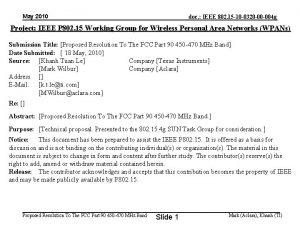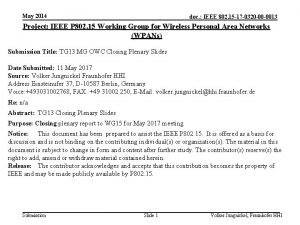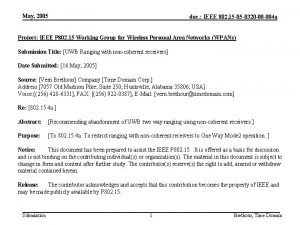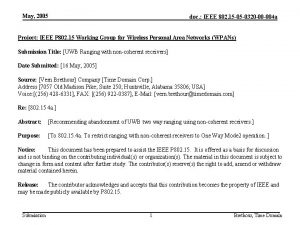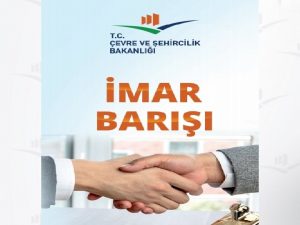Mar 2010 doc IEEE 802 11 10 0320






- Slides: 6

Mar. 2010 doc. : IEEE 802. 11 -10 -0320 r 0 Improving 11 aa More Reliable Groupcast (MRG) via 11 v Directed Multicast Service (DMS) Date: 2010 -03 -13 Submission Slide 1 Hart et al. (Cisco

Mar. 2010 doc. : IEEE 802. 11 -10 -0320 r 0 Abstract • The 802. 11 v Directed Multicast Service (DMS) provides a welldefined method for requesting and establishing basic groupcast services. As such, there’s no need for 802. 11 aa More Reliable Groupcast (MRG) to define its own state machine, set of frames or sets of IEs for performing a similar function. • Also, by inheriting the existing 11 v DMS framework, 11 aa MRG leverages DMS’s richer request feature and its DMSID abbreviation. • This document accompanying normative text changes to 11 aa’s MRG in submission 10/0319 r 0 • Herein, we present an overview on those changes and the advantages that we can achieve Submission Slide 2 Hart et al. (Cisco

Mar. 2010 doc. : IEEE 802. 11 -10 -0320 r 0 Existing 11 v DMS framework offers valuable building blocks that 11 aa MRG can leverage Color key Blue: Method to describe MC & GC Red: Service/Function Green: Service management (frames, protocols) Current scenario TCLAS & TCLAS Processing DMS Req/Resp frames & DMS Req/Resp elements DMS (11 v) MRG-Direct (11 aa) TSPEC Non-MRG & MRG-Unsolicited-Retry & MRG-Block-Ack Robust AV Streaming frames & MRG Req/Resp elements 11 aa MRG 11 v DMS Disadvantages • Much duplication and redundancy • MRG has a one-time client-side request only Submission Slide 3 Hart et al. (Cisco

Mar. 2010 doc. : IEEE 802. 11 -10 -0320 r 0 By building on 11 v DMS, MRG can significantly reduce redundancy Color key Blue: Method to describe MC & GC Red: Service/Function Green: Service management (frames, protocols) Proposed scenario DMS ~ MRG-Direct >1 TCLAS & TCLAS Processing; IP TCLAS TSPEC TCLAS DMS Req/Resp frames & DMS Req/Resp elements MRG-Unsolicited-Retry MRG-Block-Ack MRG-SP MRG Req/Resp subelements 11 aa MRG 11 v DMS Advantages • Removes redundant frames and elements from the standard • MRG is (mostly) a superset of DMS − Multicast-to-unicast is one feature, not two • MRG can use DMSID as a shorthand, and gains the Change Request from DMS Submission Slide 4 Hart et al. (Cisco

Mar. 2010 doc. : IEEE 802. 11 -10 -0320 r 0 The proposed changes to MRG provide for a more streamlined MRG: • Absorb MRG Request/Response Action frames and MRG Req/Resp elements into DMS framework − Eliminate MRG Request/Response Action frames − Evolve MRG Req/Resp elements into sublements to be contained within DMS Req/Resp elements • Reuse DMS state machine so set up and teardown procedures in 9. 2. 7. 32 become additions to the DMS procedures in clause 11 • MRG subclauses in clause 10 are eliminated and instead MRG adds extra parameters in the existing DMS sub-clauses in clause 10 • Leverage the DMSID in AP to non-AP STAs frames so that references of existing MRG agreements can be abbreviated (i. e. , no need to provide full description of MRG stream every time) • Achieved by including an MRG subelement within a DMS Descriptor Submission Slide 5 Hart et al. (Cisco

Mar. 2010 doc. : IEEE 802. 11 -10 -0320 r 0 Summary • By leveraging 11 v DMS, we can streamline MRG • Normative text changes are in accompanying submission 10/0319 r 0 • Changes are contingent on 11 v submission 10/0318 r 0 being accepted at this week’s meeting Submission Slide 6 Hart et al. (Cisco







